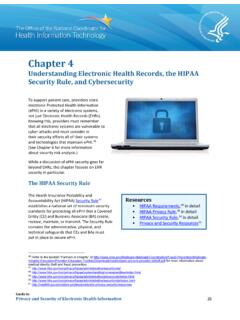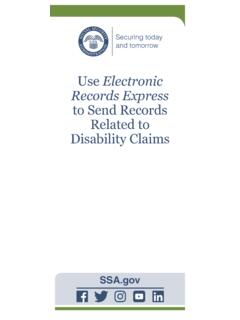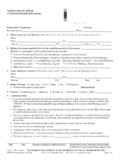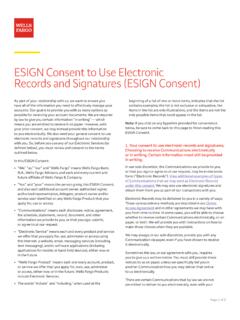Transcription of Behavioral Health Medical Records - CMS
1 1 FACT SHEETM edicaid Documentation for Behavioral Health PractitionersBehavioral Health Medical RecordsBehavioral Health practitioners are in the business of helping their patients. Patients are their priority. Meeting ongoing patient needs, such as furnishing and coordinating necessary services, is impossible without documenting each patient encounter completely, accurately, and in a timely manner. Documentation is often the communication tool used by and between professionals. Records not properly documented with all relevant and important facts can prevent the next practitioner from furnishing sufficient services. The outcome can cause unintended complications. Another reason for documenting Medical services is to comply with Federal[1] and State laws.[2] These laws require practitioners to maintain the Records necessary to fully disclose the extent of the services, care, and supplies furnished to beneficiaries,[3] as well as support claims billed.
2 In addition, proper documentation can help protect a Behavioral Health practitioner from challenges to furnished treatment, and civil, criminal, and administrative penalties and Behavioral Health Medical record Documentation RequirementsBehavioral Health services must meet specific requirements for reimbursement. Documented services must: Meet that State s Medicaid program rules; To the extent required under State law, reflect Medical necessity and justify the treatment and clinical rationale (remember, each State adopts its own Medical necessity definition);[4] To the extent required under State law, reflect active treatment; Be complete, concise, and accurate, including the face-to-face time spent with the patient (for example, the time spent to complete a psychosocial assessment, a treatment plan, or a discharge plan); Be legible, signed, and dated; Be maintained[5] and available for review; and Be coded correctly for billing are some things to avoid as a Behavioral Health practitioner.
3 Never bill chance, momentary social encounters between a therapist and a patient as valid therapeutic sessions;[6] never bill undocumented services; and never bill services coded at a higher level than those furnished. For example, if furnishing group therapy, be sure and bill group therapy codes rather than individual therapy codes, and document patient-specific information in each attendee s Medical Problems Self-AuditBehavioral Health practitioners have specific responsibilities when they accept reimbursement from a government program. They have a duty to ensure that the claims submitted to Federal Health care programs are true and accurate, [7] and that their Medical record documentation supports and justifies billed services. All practitioners documentation is open to scrutiny by many, including employers, Federal and State reviewers, and auditors.
4 [8, 9] Practitioners can protect themselves and their practices by implementing an internal self-auditing are five basic self-audit rules Behavioral Health practitioners can use to get started:1. Develop and implement a solid Medical record documentation policy if there is not one in place, even if you are a practitioner in a solo practice. If there is one in place, make sure the policy covers meeting Federal and State Medicaid regulations. The policy should address what actually happens in everyday practice. 2. Develop or use one of the available standard Medical audit tools. The tool should cover the documentation policy criteria and coding standards as part of the review. 3. Choose a staff member who understands documentation and coding principles to select a random sample of Records for a specific time period.
5 Decide how many Records should be reviewed, and then pull every nth chart for that time period. If you are a practitioner in a solo practice, you may want to ask a like practitioner to review the Resist being the one to choose and audit your own charts. Most practitioners can read their own writing and understand the meaning of Records they wrote even if the documentation is not actually in the record . Removing bias is important. For best results, make the audit as realistic as possible. 5. Use the self-audit results for improving practice compliance. There is no real value in conducting a self-audit unless discovered issues are resolved. Review and analyze the audit findings. Identify the common documentation, coding and billing problems, and solve the problems found.
6 Then educate staff members and hold them accountable for making changes. After implementing any corrective action, audit the process again to ensure improved compliance and successful Health Records (EHRs) require similar methods, but the unique nature of EHRs requires extra Make sure auto-fill and keyword features are turned off. Watch for cloned notes notes that appear identical for different visits; these may not reflect the uniqueness of the encounter or the patient s description of their chief Make sure all notes have a date and time stamp, even when updating patient history and life events. Separate notes entered at different times by paragraph returns or other clear punctuation or Make sure any edits to the patient s record are also initialed or identified with the person making the , Waste, and AbuseProperly filed claims are the responsibility of all Behavioral Health practitioners.
7 Practitioners can be culpable if they knowingly participate in fraudulent activities or know of illegal activity and do nothing.[10] Health care laws carry heavy penalties for offenders. Penalties can be administrative, civil, and criminal.[11, 12]Report Fraud, Waste, and AbuseIf you are aware of or suspect fraud, waste, or abuse, report it to the authorities: State Medicaid agency and Medicaid Fraud Control Department of Health and Human Services, Office of Inspector GeneralATTN: Hotline Box 23489 Washington, 20026 Phone: 1-800-447-8477 (1-800-HHS-TIPS) TTY: 1-800-377-4950 Fax: 1-800-223-8164 Email: Website: see the electronic version of this fact sheet and the other products included in the Documentation Matters Toolkit, visit the Medicaid Program Integrity Education page at on the CMS website.
8 Follow us on Twitter#MedicaidIntegrityReferences1 Social Security Act 1902(a)(27). Retrieved October 13, 2015, from Medicaid Services. General Provisions. 405 Ind. Admin. Code. 5-1-5. Retrieved October 13, 2015, from Social Security Act 1902(a)(27). Retrieved October 13, 2015, from Sufficiency of Amount, Duration, and Scope, 42 (d). Retrieved October 13, 2015, from Social Security Act 1902(a)(27)(A). Retrieved October 13, 2015, from State Medicaid Manual. Outpatient Psychiatric Services. Section 4221A. Retrieved October 13, 2015, from Department of Health and Human Services. Office of Inspector General. (2000, October 5). Notices. OIG Compliance Program for Individual and Small Group Physician Practices. 65 Fed. Reg. 59434 and 59435. Retrieved October 13, 2015, from Social Security Act 1902(a)(30)(A).
9 Retrieved October 13, 2015, from Post-Payment Review Process, 42 Retrieved October 13, 2015, from False Claims, 31 3729(b)(1)(A)(iii). Retrieved October 13, 2015, from Sentence of Fine, 18 3571. Retrieved October 13, 2015, from Health Care Fraud, 18 1347. Retrieved October 13, 2015, from fact sheet was current at the time it was published or uploaded onto the web. Medicaid and Medicare policies change frequently so links to the source documents have been provided within the document for your fact sheet was prepared as a service to the public and is not intended to grant rights or impose obligations. This fact sheet may contain references or links to statutes, regulations, or other policy materials. The information provided is only intended to be a general summary.
10 Use of this material is voluntary. Inclusion of a link does not constitute CMS endorsement of the material. We encourage readers to review the specific statutes, regulations, and other interpretive materials for a full and accurate statement of their 2015














